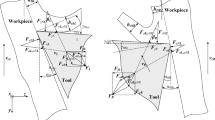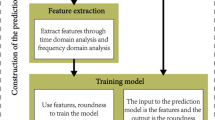Abstract
It is difficult to measure the surface roughness of large-pitch internal threads; predictions are used instead of measurements, whereas the common predictions are not highly accurate and narrow in the scope of use. The homologous isomerism data of vibration signal were utilized to establish a predictive model, which predicted the surface roughness of large-pitch internal threads. The corresponding homologous isomerism data were acquired by turning the large-pitch internal thread, and the data were processed using the Relief-F algorithm to obtain the weights, which are the effects of different features on surface roughness. Additionally, influenced by the structural characteristics of the workpiece with a large pitch and a small number of teeth, support vector machine (SVM) and radial basis function neural networks (RBF-NNs) were used to establish the predictive model with the homologous isomerism data of vibration signal as the input parameters. Eventually, the SVM model with higher accuracy of prediction and better ability of generalization was more appropriate for the research of this paper through comparison and analysis. It was verified that the absolute error of the SVM model was less than 0.05 μm, and the relative error was less than 4% for turning both left and right threaded surfaces, demonstrating that the predictive model could take the place of measuring the surface roughness in the mass production of large-pitch internal threads. The method proposed in this paper can also be extended to other parts for the prediction of surface roughness, especially those whose surface roughness is difficult to measure due to structural characteristics.










Similar content being viewed by others
Data availability
Not applicable.
References
Mackenzie A (2015) The production of prediction: what does machine learning want? Eur J Cult Stud 18:429–445
Chan TC, Lin HH, Reddy SVVS (2022) Prediction model of machining surface roughness for five-axis machine tool based on machine-tool structure performance. Int J Adv Manuf Tech 120:237–249
Yang A, Han Y, Pan Y, Xing H, Li J (2017) Optimum surface roughness prediction for titanium alloy by adopting response surface methodology. Results Phys 7:1046–1050
Kong D, Zhu J, Duan C, Lu L, Chen D (2020) Bayesian linear regression for surface roughness prediction. Mech Syst Signal Pr 142:106770
Vahabli E, Rahmati S (2016) Application of an RBF neural network for FDM parts’ surface roughness prediction for enhancing surface quality. Int J Adv Manuf Tech 17:1589–1603
Majumder H, Paul TR, Dey V, Dutta P, Saha A (2017) Use of PCA-grey analysis and RSM to model cutting time and surface finish of Inconel 800 during wire electro discharge cutting. Measurement 107:19–30
Frigieri EP, Brito TG, Ynoguti CA, Paiva AP, Ferreira JR, Balestrassi PP (2017) Pattern recognition in audible sound energy emissions of AISI 52100 hardened steel turning: a MFCC-based approach. Int J Adv Manuf Tech 88:1383–1392
Plaza EG, López PN (2018) Analysis of cutting force signals by wavelet packet transform for surface roughness monitoring in CNC turning. Mech Syst Signal Pr 98:634–651
Arulraj JGA, Wins KLD, Raj A (2014) Artificial neural network assisted sensor fusion model for predicting surface roughness during hard turning of H13 steel with minimal cutting fluid application. Procedia Mater Sci 5:2338–2346
Salgado DR, Cambero I, Marcelo A, Alonso FJ (2009) Surface roughness prediction based on the correlation between surface roughness and cutting vibrations in dry turning with TiN-coated carbide tools. Proc Inst Mech Eng, Part B 223:1193–1205
Rosenfeld MG, Lin CR, Amara SG (1982) Calcitonin mRNA polymorphism: peptide switching associated with alternative RNA splicing events. P Natl Acad Sci 79:1717–1721
Fu X, Li Z, Zheng M, Wang X, Li J (2019) Cutting stability and optimization of process parameters for the large-pitch screw high-feed turning. Proc Inst Mech Eng, Part C 233:6851–6865
Urbanowicz RJ, Meeker M, La Cava W (2018) Relief-based feature selection: introduction and review. J Biomed Inform 85:189–203
Lei Y, He Z, Zi Y, Hu Q (2007) Fault diagnosis of rotating machinery based on multiple ANFIS combination with GAs. Mech Syst Signal Pr 21:2280–2294
Jordan MI, Mitchell TM (2015) Machine learning: trends, perspectives, and prospects. Science 349:255–260
Sánchez-Fernández M, de-Prado-Cumplido M, Arenas-García J, Pérez-Cruz F (2004) SVM multiregression for nonlinear channel estimation in multiple-input multiple-output systems. IEEE T Signal Proces 52:2298–2307
Shen W, Guo X, Wu C (2003) Forecasting stock indices using radial basis function neural networks optimized by artificial fish swarm algorithm. Knowl-Based Syst 24:378–385
Wang W, Xu Z, Lu W, Zhang X (2003) Determination of the spread parameter in the Gaussian kernel for classification and regression. Neurocomputing 55:643–663
Acknowledgements
The authors gratefully acknowledge the Harbin University of Science and Technology, People’s Republic of China, for providing funds and facilities under research grants KYYWF-0349 and 51575148 to conduct this research.
Funding
This work is supported by the Fundamental Research Fundation for Universities of Heilongjiang Province (KYYWF-0349) and the National Nature Science Foundation of China (51575148).
Author information
Authors and Affiliations
Contributions
Qin was responsible for the literature study, data analysis, and writing the paper. Li and Fu were the supervisors of this work. They proposed the research idea, technical scheme, and all needed support conditions. They also participated in the data analysis and were responsible for completing the article. Jiang was involved in the discussion and data analysis. Cong and Zhang were involved in the discussion and significantly contributed to making the final draft of the article. All the authors read and approved the final manuscript.
Corresponding author
Ethics declarations
Ethics approval
Not applicable.
Consent to participate
All authors contribute and participate in the work carried out in this paper.
Consent for publication
The authors of this paper agree to publish this work in the International Journal of Advanced Manufacturing Technology.
Competing interests
The authors declare no competing interests.
Additional information
Publisher's note
Springer Nature remains neutral with regard to jurisdictional claims in published maps and institutional affiliations.
Rights and permissions
Springer Nature or its licensor (e.g. a society or other partner) holds exclusive rights to this article under a publishing agreement with the author(s) or other rightsholder(s); author self-archiving of the accepted manuscript version of this article is solely governed by the terms of such publishing agreement and applicable law.
About this article
Cite this article
Li, Z., Qin, X., Fu, X. et al. Prediction for surface roughness of the large-pitch internal thread based on homologous isomerism data. Int J Adv Manuf Technol 126, 2053–2064 (2023). https://doi.org/10.1007/s00170-023-11232-4
Received:
Accepted:
Published:
Issue Date:
DOI: https://doi.org/10.1007/s00170-023-11232-4




